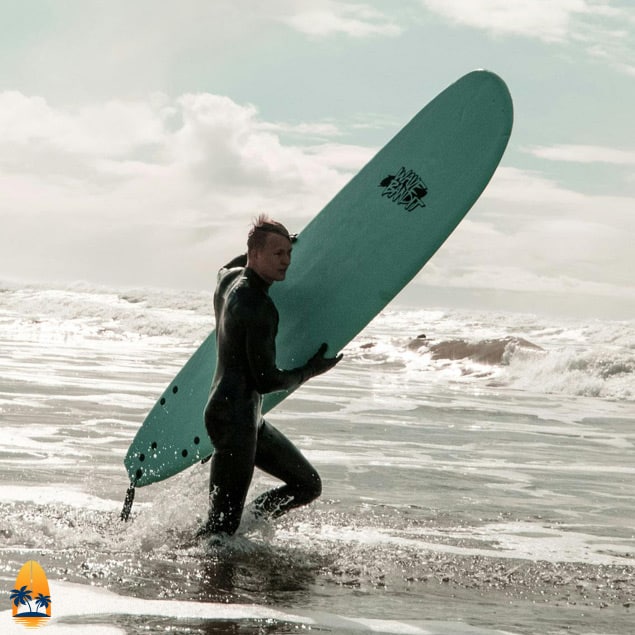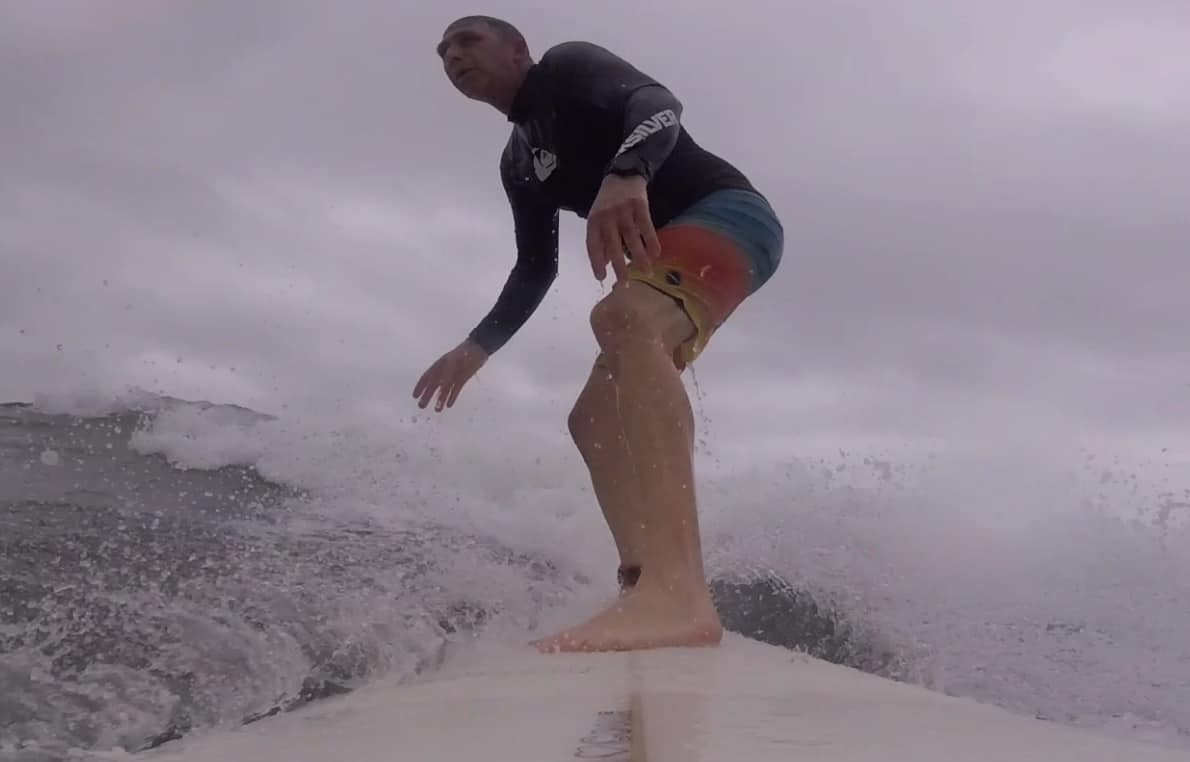When I bought a soft top as my first surfboard I had a lot of doubts I had made the wrong decision. Now, more than ten years later, I am glad I did. From time to time I still take my soft top “foamy” out for some fun in the waves. It doesn’t matter if you are a new surfer or a pro like Jamie O’Brien riding soft tops is a great way to learn and have some fun. In this post, I’m going to go over some of the gnarliest soft top surfboards and brands as well as cover some FAQs about them.
Odysea Soft Top Boards

Odysea boards, made by Catch Surf, are great for fun and functional surfing. They come in many styles and sizes. The Odysea Log is a popular choice because it’s good for small to medium waves. These boards are known for being durable and having cool designs.
- Key Features: Fun designs, durable.
- Pros: Strong and come in many styles and sizes.
- Cons: Can be kind of expensive.
- Price Range: $200 – $600
- User Reviews: Loved for durability and performance in small to medium waves.
- Availability: Odysea SurfBoards Online / Many Surfshops Around The World
The Odysea Log is the soft top board that pro surfer Jamie O’Brien rode at the Bonzai Pipeline during the Pipe Masters Surfing Competition. Jamie’s video is insane! Pipeline is one of the gnarliest surf spots on the planet. So anyone saying that soft tops are lame or that you can’t ride one like a “real board” doesn’t know what they are talking about.

Wave Bandit Soft Tops

Wave Bandit boards, also by Catch Surf, are known for their bright designs and strong build. The Beater Board is a favorite for beginners and pros because it works well in all conditions.
- Key Features: Bright designs, strong, works in all wave conditions.
- Pros: Very durable, good for all skill levels.
- Price Range: $175 – $400
- User Reviews: Praised for performance and durability. Surfers love the Beater Board.
- Availability: Wave Bandit SurfBoards Online / AMAZON.com / Surfshops Around The World
Softech Soft Top Surfboards

Softech makes high-performance soft top surfboards for all skill levels. They feel like traditional surfboards but have the safety of a soft top. They have different models, like the Flash Eric Geiselman, which works well in various wave conditions.
- Key Features: High-performance, traditional surfboard feel.
- Pros: Great performance, many models for different skill levels.
- Cons: On the more expensive side.
- Price Range: $375 – $550
- User Reviews: Praised for performance and quality.
- Availability: Softtech Surfboards Online / Many Surfshops
Mick Fanning Soft Tops

Professional surfer Mick Fanning designed these soft top boards to mix performance and ease of use. They’re durable and have advanced features. The Mick Fanning Ally Cat is great at catching waves and is stable and responsive. It’s perfect for both beginners and experienced surfers.
- Key Features: High-quality materials, and innovative designs.
- Pros: Durable, high performance, innovative features.
- Cons: Higher end of the price range.
- Price Range: $300 – $800
- Availability: Mick Fanning Soft Boards Online / Select retailers and many surf shops.
Wavestorm Soft Top Surfboards

Wavestorm is very popular with beginners. Their boards are affordable, strong, and stable, making them great for learning to surf. The Wavestorm 8’ is commonly used at surf schools because it’s easy to use.
- Key Features: Affordable, very stable, widely available.
- Pros: Great for beginners, stable, affordable.
- Cons: Less suited for advanced surfers.
- Price Range: $100 – $200
- User Reviews: First board for many surfers due to stability and price.
- Availability: Wave Storm Boards, Amazon.com, Costco and some online stores.
Soft Top Surfboard FAQs
How Long Do Soft Top Surfboards Last?
Soft tops are built tough for beginners, but their lifespan depends on use and care. Most—like a Wavestorm or Catch Surf Odysea—can last 2-5 years with regular surfing (say, 20-30 sessions a year). Avoid leaving them in direct sun for days or dragging them across rocky beaches—that’ll shred the foam faster. Waxing the deck helps too; it keeps traction solid so you’re not slipping off after a season. Want one that lasts?
Can You Surf Big Waves with a Soft Top Surfboard?
You can, but it’s not ideal. Soft tops shine on small-to-medium waves (1-4 feet)—perfect for learning. Their thick foam and wide shape give stability, not speed or control for gnarly 6-foot+ swells. Pros sometimes rip big waves on boards like Catch Surf’s Beater for fun, but as a beginner, stick to mellow breaks. If you’re eyeing bigger waves later, start with a softie like Wavestorm [affiliate link] and upgrade to a hardboard when you’re ready.
Why Do Soft Top Surfboards Feel Slippery at First?
New soft tops often have a slick factory finish—great for gliding, bad for grip. That’s why your feet might slide until you wax it up. Grab some surf wax (cold-water wax if you’re in chillier spots) and rub it on the deck in circles—focus where your feet land. Traction pads work too, but wax is cheaper and does the trick. Snag some here [affiliate link to wax] and you’ll stick those turns no problem
What Is A Soft Top Surfboard?
A soft top surfboard has a soft, foam top, making it safer and easier for beginners. It usually has an EPS foam core and a slick bottom for better performance.
Who Should Use A Soft Top Surfboard?
Beginners benefit from their stability, buoyancy, and safety. They’re also fun for experienced surfers.
Do Soft Top Boards Need Wax?
No, they don’t “NEED” wax, but adding a little wax to soft tops adds a lot of grip for your feet!
How Do Soft Top Surfboards Compare To Traditional Ones?
Soft tops are more buoyant, and stable, but don’t perform as well as fiberglass boards for advanced surfers.
Are Soft Top Surfboards Durable?
Yes, they resist dents and dings well but can still be damaged by sharp objects.
Can Soft Top Surfboards Be Repaired?
Yes, soft top surfboards can be repaired. The process is much different from repairing traditional fiberglass boards. Soft tops have a foam core covered with a soft, durable outer skin, which can get damaged from dings, punctures, or delamination. Minor repairs, like small cuts or punctures, can be fixed using waterproof adhesive or specialized repair kits designed for soft top boards.
Can I Do Advanced Tricks On A Soft Top Surfboard?
In all honesty, it depends on your ability on a surfboard. With that said, some soft tops are better than others when it comes to performance.
How Do I Take Care Of A Soft Top Surfboard?
Rinse with fresh water after use, store in a cool place, and avoid direct sunlight. Also, make sure you remove and rinse off your leash and let it hang dry.
What Size Soft Top Surfboard Should I Get?
My general suggestion would be, that beginners should use longer boards (8-9 feet). More advanced surfers might prefer shorter boards (6-7 feet). Of course, this all depends on your height, weight, and overall surfing ability. You can also check out our post that goes over beginner surfboard size.
Soft Top Surfboards For Big Guys And Ladies
If you have a concern about weight, most 9′ and 10′ soft top surfboards should be ok for those up to about 300lbs.
Let’s say you are bigger than 300lbs, does that mean you won’t be able to surf? NO! Though the cost may be a little higher, getting a SUP (Stand Up Paddle) board should work out perfectly for you.
SUP Boards are wider and have a much higher volume than almost all surfboards. Often called a floating sidewalk may not be the most ideal way to learn, but it is TOTALLY POSSIBLE!
Do Soft Tops Need Fins?
Yep, they do—and most come with ‘em. Fins keep you tracking straight instead of spinning like a top. Soft tops like INT or Catch Surf usually include removable plastic fins—easy to swap if they snap (which happens if you hit shallow sandbars). No extra fins needed to start, but if you lose one, grab a replacement set here at amazon.com. Pro tip: check they’re screwed in tight before you paddle out!
Can Children Use Soft Top Surfboards?
Yes, they are safe and easy for kids, with smaller sizes available.
Why Do People Not Like Soft Tops
Some people dislike soft top surfboards because they are often perceived as less durable and less performance-oriented compared to traditional fiberglass boards. Soft tops are generally heavier and less responsive, which can make maneuvering and performing advanced techniques more challenging.
Final Thoughts:
Surfing is all about having fun! Yes, learning can be difficult, but soft tops can make it a little easier. For those who can surf and are looking for a little more fun, a soft top board is a perfect addition to any quiver. There are plenty of soft top surfboard brands out there and it won’t be hard to find one that suits you best. So, grab you a soft top board, hit the waves, and enjoy the ride!
We would love to hear your thoughts on soft tops! Love them or hate them, share your story! Drop a comment down below or shoot us a message on the contact page.


